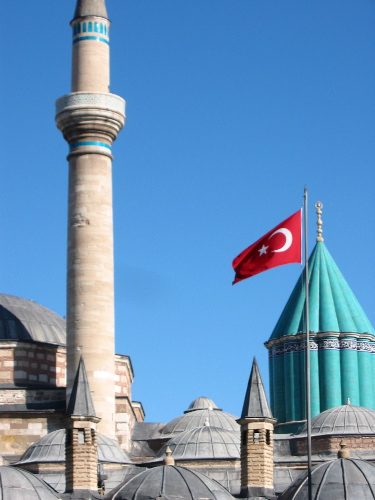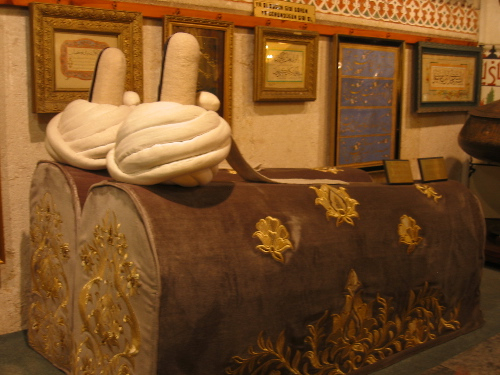Next we head for the Mevlana museum in Konya,
I had been intrigued by the twirling Dervishes ever since a friend gave me a painting he had made of them. Contrary to what one might believe, the twirling dervishes do not give a performance, the Sema is a sacred ritual, accomplished by muslim priests who get into a prayer trance with Allah. The dervishes are members of a brotherhood: the order of Mevlevi, founded by Mevlana Rumi in the 13 the century.
The Semazens, wear a brown felt hat (sikke) which represents the ego’s tomb and a wide white skirt that represents the shroud of the ego. And when they remove their black capes, they are reborn to truth. They stand with folded arms waiting for their turn. When they start to turn, they open up their right hand towards the sky as a sign of prayer and turn their left hand
towards the ground. Each rotation has them pass in front of the sheikh. It is the place of Mevlama Rumi and the way to divine grace.
In an adjoining room, men dressed in white, provide musical accompaniment. The music, called “sufi” is meant to cleanse the heart’s mirror.
The danse master, called “semazenbashi” wears a white hat and sits in the seat of honour, on a red carpet pointing to mecca.
The Sema ritual is composed of four “sealms” or musical movements, each one having it’s own rythm and symbolism. They correspond to the components of human nature: spirit, emotions and soul.
So, the Semazens come forward, raising their arms towards the sky, and they start turning. One foot stays on the ground, while the other crosses over and propulses the dancer. They must maintain an axis that prevents diziness by staring at the sheikh in the center of the circle of dancers. They make little circles controlled by their head, hands and arms while they turn. They make from 20 to 30 circles per minute. Each session lasts about fifteen minutes.
This “danse” is a prayer to Allah. The ceremony ends with a prayer for the peace of the souls of prophets and believers.Then the dancers put their capes back on and leave in silence to go meditate in their room.
We did get to attend the ritual in a caravanserai. We had been warned not to take pictures or applaud. It was very impressive: the darkened stone hall, the church like ambiance, the mysterious sound of the flute… I was sitting very stiffly on my wooden bench. As the music started, I felt something hit my shoulder and fall on my lap. It was too dark for me to see, so I brushed it off thinking it must be a frog. But as I looked up to the very high vaulted ceilings it became obvious that a frog could not have climbed up there…it had to be a bat! And now it was somewhere around my feet. I was wearing sandals and truly did not want to have a bat crawling up my leg so I raised my feet off the ground hoping it would walk away, not knowing if bats CAN walk…I was so petrified that I remained in that position until the end of the ritual. Our guide had told us that some people come out of there transformed…HA! I can see why….
Konya, known as Iconium during Roman times, is one of the oldest inhabited cities of Turkey. The sultan Alaeddin Keykubad welcomed Jalalad-Din Runi, better known as Mevlana ( the master) founder of the whirling dervishes. In the 18th century, Mevlana founded a convent in Konya, to train the new twirling dervishes who were destined to twirl around the world to spread the good word. Mevlana’s mausoleum is inside this building.
There are also several funerary stalls, as well as old costumes, prayer carpets, musical instruments and spectacular Corans in various sizes…
Take me to Turkey Part 9 – Caravanserai



One thought on “Turkey – Mevlana Museum”